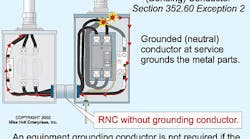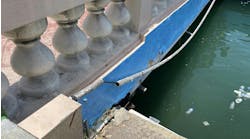Stumped by the Code?
Q.
Is there an NEC requirement that an equipment grounding conductor be installed in PVC conduits?
A.
Kind of. Sec. 352.60 states that where equipment grounding (bonding) is required by Art. 250, a separate equipment grounding (bonding) conductor must be installed in the conduit.
So if equipment grounding (bonding) is required by Art. 250, and the installation is nonmetallic conduit, then an equipment grounding (bonding) conductor must be installed.
But the exceptions to 352.60 permit the grounded (neutral) conductor to be used for bonding at the following locations [250.142(A)]:
-
On the supply side or within the enclosure of the service disconnecting means [250.24(B), 350.60 Exception 2] (Fig. 1).
-
On the supply side or within the enclosure of the disconnecting means for separate buildings [250.32(B)].
-
On the supply side or within the enclosure of the disconnecting means of separately derived systems [250.30(A)(1)].
Q.
Can I use one single-pole 15A, 125V AFCI breaker and one 15A, 125V non-AFCI circuit breaker with 14/3 nonmetallic sheath cable to supply an AFCI-protected dwelling unit bedroom circuit and another circuit that isn't AFCI protected?
A.
No. A single-pole AFCI circuit breaker, just like a single-pole GFCI circuit breaker, isn't designed to operate on a multiwire branch circuit. Use the new 14/4 NM cable that's manufactured for this purpose.
Q.
What's the proper way to replace two-prong receptacles with a grounding type receptacle in an older house where no ground wire is located in the outlet box?
A.
Where no grounding means exists in the outlet box, a nongrounding-type receptacle can be replaced with a GFCI receptacle if marked “No Equipment Ground,” or a grounding type receptacle, if GFCI-protected and marked “GFCI Protected” and “No Equipment Ground.” See 406.3(D)(3) for details.
Q.
We recently designed an upgrade to an existing imaging center that has 208V, 3-phase service. We're adding additional equipment that requires 480V, 3-phase, and we designed a separate service to supply the new 480V equipment. The permit plan reviewer, stating that the NEC didn't allow two services to the same building, rejected the plans. It's my belief that 230.2(D) permits this design for differing voltages. What's your opinion?
A.
You're right. Per 230.2(D), “additional services shall be permitted for different voltages.” You also need to comply with 230.2(E), which requires a building supplied by more than one service to have a permanent plaque or directory at each service disconnect location denoting all other services supplying that building and the area they serve. Use the same grounding electrode for both services (250.58).
Q.
How do you size the conductor and protection device for a 15kVA, 240V, 3-phase space heater?
A.
Conductors and protection devices for electric space heating equipment may be no smaller than 125% of the ampere rating of the equipment [424.3(B)].
Equipment Ampere Rating=kVA÷(V×1.732)=15,000÷(240V×1.732)
Equipment Ampere Rating=36A
Conductor and Protection not Less Than=36A×1.25=45A
Conductor=6 AWG for 60°C terminals or 8 AWG for 75°C terminals [110.14(C)]
Protection=45A or 50A device [240.6(A)]
Q.
I have a situation where a contractor used 15A, 125V receptacles on a 20A circuit with 12 AWG conductors and 14 AWG pigtails to the 15A receptacles. Is a 20A rated receptacle required and should the conductors to the receptacle be at least 12 AWG?
A.
Yes and no. A 15A rated receptacle can be connected to a 20A branch circuit that supplies two or more receptacles. This would include a single duplex receptacle, because it contains two receptacles [210.21(B)(3)]. However, the tap rule contained in Exception No. 1 of 210.19(A)(4) is intended to prohibit the use of a 14 AWG pigtail from a 12 AWG branch circuit conductor protected by a 20A overcurrent protection device. So it's OK to install a 15A, 125V rated receptacle on a 20A circuit, but you can't install a 14 AWG pigtail on a 20A circuit.
Q.
Sec. 310.4 defines conductors in parallel as “electrically joined at both ends to form a single conductor.” If we have two sets of parallel conductors in a single raceway — a total of six physical conductors — must we apply the ampacity adjustment factors contained in 310.15(B)(2)(a)? Some engineers feel that if we electrically join the conductors to form a single conductor, we only have three conductors, not six.
A.
These “simple” questions are never that easy to answer. You have to consider conductor size to accommodate continuous loading, overcurrent protection, and conductor ampacity.
If you have six physical conductors in a raceway, then you have six conductors in the raceway for conductor ampacity adjustment purposes. The definition of a parallel conductor contained in 310.4 only applies to 310.4 for the purpose of applying the requirements contained in 310.4. Let's look at an example to help illustrate the requirements set forth in this rule.
Example: Can 3/0 AWG THHN, paralleled in a single raceway, and protected by a 400A protection device be permitted to supply a 320A continuous load on a panelboard?
Continuous load.
The maximum continuous load may not exceed 80% of the conductor ampacity before the application of any adjustment factors [215.2(A)(1)]. The 3/0 AWG THHN parallel set has an ampacity of 400A at 75°C before ampacity adjustment, so it meets the continuous load size requirements.
Conductor ampacity.
The ampacity of six 3/0 AWG THHN conductors installed in the same raceway must be adjusted by the 80% multiplier contained in Table 310.15(B)(2)(a).
3/0 AWG THHN adjusted ampacity=225A (at 90°C)×0.80=180A×2=360A
Conductor adjustment is based on the conductor ampacity at the temperature rating of the conductor insulation, in this case 90°C, not the 75°C terminal rating of the equipment. Read the last sentence in the first paragraph of 110.14(C).
Overcurrent protection
Sec. 240.4(B) permits the 360A rated conductors to be protected by a 400A protection device, according to the “next size up” rule.
Q.
What are the working space requirements for 120V industrial machinery?
A.
Where maintenance and supervision conditions ensure that only qualified persons will service the installation, the working space from live parts for 120V circuits must be at least 2.5 ft (670.5).
However, where it's necessary to use a tool to open the enclosure, and where only diagnostic and troubleshooting testing is involved, the clearances can be less than 2.5 ft. How much less is a judgment call for the AHJ to make.
The 2.5-ft working space rule only applies to 120V circuits. If the equipment is rated 208V, 240V, 277V, or 480V, then the working space requirements must comply with the more stringent requirements contained in 110.26.
Q.
The luminaires in the men's bathroom in my building are controlled by occupancy sensors that don't have a manual override switch. When there's no motion for 3 min or more, the luminaires shut off — even if the stalls are occupied — and the room goes dark. Trust me, I know. Because the motion sensor is located so far from the stalls, an occupant must leave the stall for the sensor to “see” movement before the luminaire will turn back on. Does the NEC permit this installation?
A.
Yes. This is a design issue [90.1(C)]. The NEC doesn't require habitable rooms in commercial occupancies to have lighting, receptacles, or switches. Therefore the bathroom occupancy sensor need not be equipped with a manual override switch. However, if this were a dwelling unit bathroom, the installation would violate of 210.70(A)(1), which requires the bathroom wall switch to be equipped with a manual override that would allow the sensor to function as a wall switch.
Ultrasonic sensors are “volumetric” in that they send out sound waves to “fill” a space and then use the Doppler Effect to detect any motion that causes a shift in the returning sound waves. This permits detection behind stall walls in bathrooms.
In contrast, passive infrared or PIR sensors are line-of-sight and need to “see” the area that's being detected. Therefore, they don't work if there's a barrier — in this case, a stall wall — between the sensor and what is being detected.
Q.
Can you install a 3-phase main breaker panel for a single-phase service and a 3-phase breaker for a single-phase panel?
A.
There's nothing in the NEC that would prohibit this installation. However, 110.3(B) requires electrical equipment to be installed and used in accordance with any instructions included in the listing or labeling.
Q.
Does the Code require a local disconnect on the primary side of a transformer?
A.
No, just overcurrent protection in accordance with 450.3(B). However, transformers rated greater than 600V installed in tunnels must have a switch or circuit breaker that simultaneously opens all ungrounded conductors of the circuit within sight of each transformer.
Q.
I think 120V outdoor receptacles for sump pump equipment and drinking fountains in commercial/industrial settings should be GFCI-protected. Is there an NEC article that addresses this situation directly or indirectly?
A.
Sorry, but the NEC doesn't require GFCI protection for any of these applications. However, it's possible — but highly unlikely — that a local municipality might have a legal requirement mandating encased electrodes for all new construction.
Q.
I'm handling an automobile claim for an insurance company in which one of its customers was driving a truck and struck an electrical wire that was attached to a building. The tractor-trailer was 13 ft 6 in. tall. I'm trying to determine if the NEC lists the height requirement for electrical wiring above parking lot and streets. It's my opinion that I can deny this loss based upon the fact the height of the wire was below the standard.
A.
If the wiring is a service drop owned by the utility, then the heights given in the National Electric Safety Code (NESC) apply. Per the NEC, the minimum height of overhead conductor spans not owned by the electric utility over public streets, alleys, roads, and parking areas subject to truck traffic may not be less than 18 ft [225.18].
Q.
Some 480V-120/208V, 3-phase transformers come shipped with a bonding strap that connects the XO terminal to the case of the transformer. My boss told me to install a bonding jumper sized to Table 250.66 and based on the secondary conductors and leave this factory-bonding strap in place. Is this really required by the NEC?
A.
No. You're not required to add an additional bonding jumper if the transformer is listed by a qualified electrical testing laboratory (90.7). It's true that 250.30(A)(1) requires a bonding jumper sized in accordance with Table 250.66 to bond the XO terminal to the case. But if the manufacturer has installed one, then there's no need for you to add an additional bonding connection.
Need some help with an installation? Clashing with your local inspector? E-mail Mike at [email protected] with a description of the situation and your question may show up in a future column.
CLARIFICATION
Mike's response in August to a question about expansion fittings for rigid nonmetallic fittings was unclear. The text in the accompanying figure stated that there wasn't a straight run of RNC between elbows, so an expansion fitting wasn't required. However, the 2002 NEC states in 352.44, “Expansion fittings for RNC shall be provided to compensate for thermal expansion and contraction…in a straight run between securely mounted items such as boxes, cabinets, elbows, or other conduit terminations.” The new graphic above more clearly states the intent of the Code. EC&M regrets the error.




